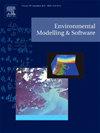使用地面站观测和遥感数据估算实际蒸散发的物理约束深度学习框架
IF 4.6
2区 环境科学与生态学
Q1 COMPUTER SCIENCE, INTERDISCIPLINARY APPLICATIONS
引用次数: 0
摘要
蒸散发(ET)是水循环的一个关键过程。虽然基于机器学习的方法越来越多地应用于ET估算,但它们通常忽略了物理机制和生态影响。本研究提出了一种物理约束混合模型(TST- phy),该模型将penman - monteith衍生的物理知识纳入时间序列变压器(TST)。该框架集成了贝叶斯优化,在数据驱动的建模工作流中自动确定物理机制的最优权重。以中国北方干旱半干旱区为研究区,结果表明,所提出的框架能较好地平衡估算误差和物理规律,其值约束权和趋势约束权分别为0.26和0.41。适当的物理约束可以提高TST-PHY在不同时空尺度上的预测精度、泛化和物理一致性。综上所述,本研究通过数据驱动和知识驱动模型的协同集成,建立了数据稀疏地区蒸散发估算的新范式。本文章由计算机程序翻译,如有差异,请以英文原文为准。
A physics-constrained deep learning framework for actual evapotranspiration estimation using ground station observations and remote sensing data
Evapotranspiration (ET) is a key process in the water cycle. While machine learning-based methods have been increasingly applied to ET estimation, they typically neglect physical mechanisms and ecological impacts. This study proposes a physics-constrained hybrid model (TST-PHY) that incorporates Penman-Monteith-derived physical knowledge into the time series transformer (TST). The framework integrates Bayesian optimization to automatically determine optimal weights for physical mechanisms within the data-driven modeling workflow. The arid and semi-arid regions of Northern China (ASNC) were chosen as the study area, and our results show that the proposed framework optimally balances estimation error and the physical law, with value and trend constraint weights of 0.26 and 0.41, respectively. Moreover, proper physical constraints can improve the prediction accuracy, generalization, and physical consistency of TST-PHY at various spatiotemporal scales. In conclusion, this study establishes a novel paradigm for evapotranspiration estimation in data-sparse regions through the synergistic integration of data-driven and knowledge-based models.
求助全文
通过发布文献求助,成功后即可免费获取论文全文。
去求助
来源期刊

Environmental Modelling & Software
工程技术-工程:环境
CiteScore
9.30
自引率
8.20%
发文量
241
审稿时长
60 days
期刊介绍:
Environmental Modelling & Software publishes contributions, in the form of research articles, reviews and short communications, on recent advances in environmental modelling and/or software. The aim is to improve our capacity to represent, understand, predict or manage the behaviour of environmental systems at all practical scales, and to communicate those improvements to a wide scientific and professional audience.
 求助内容:
求助内容: 应助结果提醒方式:
应助结果提醒方式:


